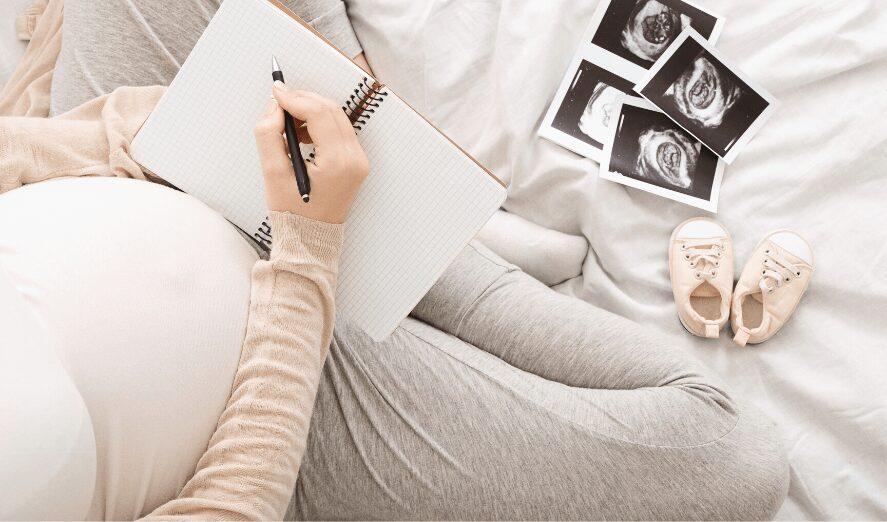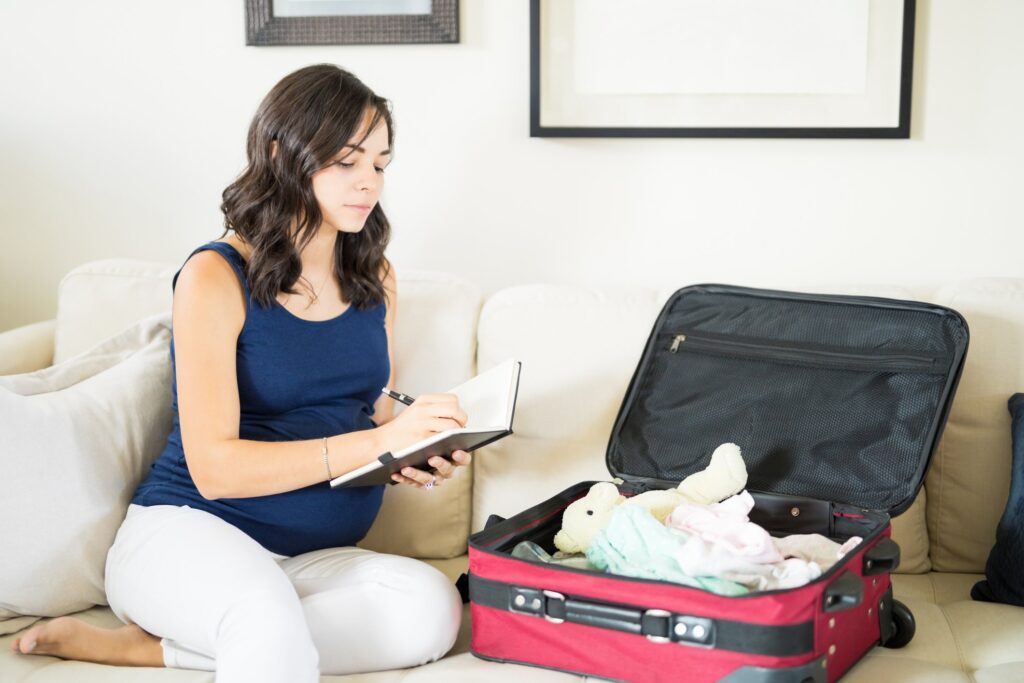The countdown is on to your baby’s arrival. The excitement is building, and so is your to-do list.
Preparations begin as soon as you confirm your happy pregnancy news, then kick into high gear during your third, fourth, and fifth month of pregnancy and beyond.
Prepare for labor

Preparing for labor can start as early as your first trimester and continues throughout your third.
First trimester
Preparing-for-labor exercises
Integrating physical activity into your daily routine can enhance your endurance and strengthen key muscle groups you’ll need for labor. Ask your doctor about these preparing-for-labor exercises:
- Kegels. Kegel exercises target your pelvic floor muscles, which play a vital role in supporting your uterus, bowel, and bladder, particularly during labor when it’s time to push. To find the muscles, stimulate the sensation of needing to urinate and then stop. To perform the exercise, contract the muscles, hold for 10 seconds, then release. Aim for 10 to 15 repetitions, two to three times daily.
- Pelvic tilts. These exercises, which can be done lying down or standing up, strengthen your abdominal and pelvic muscles. They may help minimize back pain once you’re in labor.
- Squats. Squatting can expand your pelvic opening, potentially facilitating a smoother birthing process. As a bonus, they may also help ease lower back discomfort during pregnancy.
Second trimester

Choose birth location
Around four months pregnant, you may want to start thinking about where you’d like to give birth. You may be required to give birth at the hospital your OB-GYN is affiliated with, but if you do have a choice, some factors you may want to consider include:
- If the location accepts your insurance and what your out-of-pocket expenses could be
- Distance from your home
- Maternity care team and facilities to handle emergencies or high-risk pregnancies
- Options for using a midwife or doula
Create a birth plan
A birth plan is a written document for you, your doctor or midwife, and your loved ones that outlines your preferences for labor and delivery. It’s not a must-have, but it can be a helpful way to communicate what’s important to you and allows your partner to advocate for you as well. A birth plan can be as simple or as detailed as you wish but typically includes answers to the following:
- Where will you deliver?
- What protocol should you follow once labor begins? Should you call your doctor first or go right to the hospital?
- How will you get to the birthing location?
- Do you have or want a doula?
- Whom do you want to be present to support you during the birth?
- What position can you be in while pushing and during delivery?
- What are your pain medication preferences?
- Who do you want to cut the umbilical cord?
- Do you want immediate skin-to-skin contact?
- If unforeseen situations arise (for instance, the need for an episiotomy or a C-section), what choices would you consider?
While the birth plan is often created around month six of pregnancy, it’s not set in stone and can be changed throughout your pregnancy, even while you’re in labor. Remember that labor and delivery can be unpredictable, and the most important thing is the health and safety of you and your baby. Still, a birth plan can be a valuable tool to help your doctors understand your wishes.
Third trimester

Take a birthing class
Childbirth education classes, often given through your hospital, can help you feel confident and less stressed during labor and delivery. Classes typically cover:
- Different labor stages
- When to call your OB-GYN or midwife
- Vaginal delivery and C-section
- Pain management options
- Birth methods such as Lamaze and Bradley
- How to be a birth partner
Birthing classes can help you learn what to expect during labor. You’ll also connect with other expectant parents and their birth partners, allowing you to talk about your shared experiences and concerns.
Eat healthy and exercise

An important part of preparing for your baby’s arrival is taking care of your body. Eating a balanced and nutritious diet is essential for both you and your baby. If you already eat well, continue to do so. If your nutrition could use a little improvement, now is a great time to make some healthy changes. Follow your doctor’s guidance for nutrition and exercise, stay well-hydrated, take a prenatal vitamin, and kick unhealthy habits like smoking.
Prepare the nursery
Creating a warm, relaxing, and inviting nursery can be a special part of these waiting-for-baby months. You may choose to set up the nursery before your baby’s arrival to ensure that everything is ready and organized in advance. Third-trimester nesting mode is the perfect time to gather the following items:
- Crib or bassinet (be sure it meets current U.S. safety standards)
- Fitted crib sheets
- Firm, flat mattress that fits tightly in the crib so that there is no more than a 2-finger wide gap between the mattress and the side of the crib
- Changing table and changing pad
- Diaper pail
- Rocking chair or glider
- Nightlight
- Baby monitor
- Baskets or bins
- Dresser
- Age-appropriate toys
- Laundry hamper
- Baby clothes hangers
- Closet organizer
And, of course, have fun decorating your baby’s room. Whether you prefer a modern, whimsical, or traditional style, select a color palette or theme, adorn the walls with baby-friendly artwork, and create a serene, joyful, and inviting space to welcome your little one.
Stock up on all the baby necessities

Babies may be little, but they need lots of things. Here’s a list of some newborn necessities you’ll want to have on hand:
- Car seat (follow National Highway Traffic Safety Administration recommendations when selecting)
- Diapers, diaper rash cream, and wipes
- Stroller and stroller blankets
- Swaddles
- Pacifiers
- Bottles
- Nursing items, including nursing pads, breast pads, a nursing pillow, breast pump, and breastmilk storage bags
- Playmat for tummy time
- Burp clothes
- Washcloths and towels
- Portable changing mat
- Baby bath, soap, and baby laundry detergent
- Clothing including onesies, shirts, rompers, pants, pajamas, socks, hats, sweaters, and jackets
Getting an idea of what you may need early in your pregnancy gives you time to research, comparison shop, and ask other parents and your doctor for advice on the best products.
Pack your hospital bag

Get ready for go-time and put together your hospital bag well before your due date. You’ll need items for yourself, your partner, and your baby. Here’s a quick list of essentials:
For you:
- Comfortable clothes, including tops with openings or buttons in the front if you will be breastfeeding
- Going home outfit
- One or two pairs of warm pajamas
- Nursing items
- Socks and slippers
- Toiletries
- Extra maternity underwear
- Sanitary pads
- Pillows
- Glasses or contacts
For your partner:
- Comfort clothes, including a sweatshirt and a nice outfit for those first pictures
- Pillow and blanket
- Snacks and water bottle
- Medications for you or your partner
For the baby:
- Going home outfit
- Blanket
- Baby care items and diaper bag
- Car seat already installed in your car
Other items:
- Phones and chargers, headphones, or even a laptop to pass the time during a long labor
- Picture ID, insurance information, and hospital forms
- Print out of birth plan
- Cash and change
Prepare the family

Once your baby arrives, your family’s dynamics will change. Here are some suggestions for easing the adjustment:
Talk to your other children and get them involved. If you have other children, talk to them about the new sibling on the way. Show them pictures of themselves as newborns, and let them feel the baby kicking inside your belly. Involve them in setting up the nursery and let them choose a toy for their baby brother or sister.
Take a babymoon. As for your partner, consider a babymoon where you can get away for a little bit. Your vacation doesn’t have to be elaborate; just prioritize togetherness, enjoyment, and expressing appreciation for each other. When to go? The second trimester may be prime time as you might be over the morning sickness hump and feeling more energetic. Just be sure to talk to your doctor before traveling far.
If you can’t swing a babymoon, plan date nights. Focus on romance, relaxation, and fun. Go out to eat, take day trips, book a couple’s massage, or spend time in nature.
Enjoy some “me” time

Take advantage of these pre-baby months to pamper yourself.
Get some serious slumber. Sneak in as many naps as you need. Hit the snooze button and sleep in late. If you have other children, ask someone to watch the kids so you can stay in bed. Now is the time to get as much rest as you can.
Focus on self-care. Take care of yourself physically and emotionally. Get a manicure or facial and have lunch with friends. Practice relaxation techniques, prenatal yoga, or other activities that promote your well-being. Don’t feel guilty about taking time for yourself—you deserve it!
Preparing can provide peace of mind
Getting ready for your baby is an exciting time as you set the stage to enter a new and wonderful chapter in your life. Reach out to your doctor for health and wellness guidance and to family and friends for additional support. Preparation can provide peace of mind as you await your little one’s arrival—your baby will be here and in your arms before you know it!



